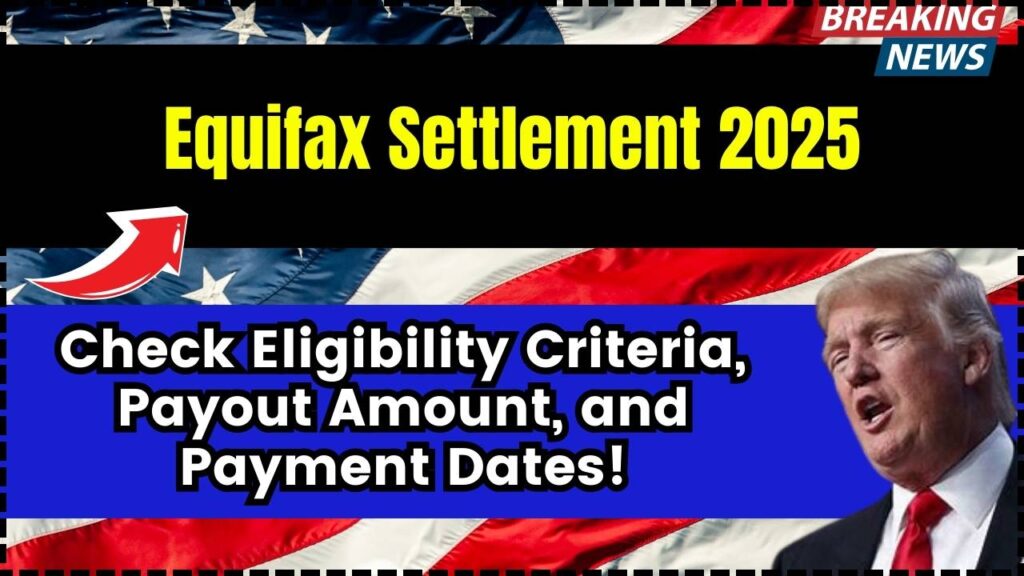Equifax Settlement 2025: In 2017, a major data breach at Equifax exposed the sensitive personal information of nearly 147 million Americans. Fast forward to 2025, and many affected individuals are looking to understand how the Equifax Settlement 2025 impacts them—whether they’re eligible, how much they could receive, and when payments are being made.

This guide is here to help you navigate all of that, with a friendly yet expert approach, and language so clear that even a 10-year-old could follow it.
Equifax Settlement 2025
| Topic | Details |
|---|---|
| Breach Year | 2017 |
| Settlement Fund Size | Up to $425 million |
| Eligible Individuals | ~147 million U.S. consumers |
| Claim Deadlines | Jan 22, 2020 (initial), Jan 22, 2024 (extended) |
| Payout Amounts | Up to $20,000 (documented losses), $25/hour (time spent) |
| Final Payout Distribution | Nov 7 – Dec 20, 2024 |
| Free Identity Restoration | Available until Jan 2029 |
| Official Site | equifaxbreachsettlement.com |
The Equifax Settlement 2025 marks the final chapter in one of the largest data breach cases in history. While the claim submission windows are closed, free identity restoration services are still available until 2029, offering vital protection against fraud and identity theft.
What Happened in the Equifax Breach?
In 2017, Equifax—one of the largest credit reporting agencies in the United States—was hacked. The attackers exploited a weakness in the company’s website to access sensitive data like:
- Social Security numbers
- Birth dates
- Addresses
- Driver’s license numbers
- Credit card information (for some)
This breach affected nearly half the U.S. population, leading to legal action and, ultimately, a massive settlement fund aimed at compensating victims and providing protective services.
Who Is Eligible for the Equifax Settlement?
You are eligible if:
- You were affected by the 2017 data breach.
- You submitted a valid claim before the required deadlines:
- January 22, 2020 (initial period)
- January 22, 2024 (extended claims)
If you missed the claim window, you may still be eligible for free identity restoration services until January 2029.
How Much Can You Get?
1. Out-of-Pocket Reimbursements
If you had financial losses related to the breach, you could be reimbursed up to $20,000, covering things like:
- Credit monitoring services
- Costs of freezing/unfreezing credit reports
- Bank fees or fraudulent charges
- Legal or notary expenses
2. Time Spent Dealing With the Breach
You could also be paid $25 per hour for up to 20 hours of your time if you:
- Called your bank to dispute charges
- Set up credit monitoring or alerts
- Filed reports or did paperwork related to identity theft
Note: The final payout amounts may be lower than the maximum if many people filed claims.
When Will You Get Paid?
- Payouts for early claimants began in 2022 and continued through 2023.
- Final payments for extended claims were sent out between November 7 and December 20, 2024.
Haven’t received your payment yet? You can check the status of your claim by visiting the official settlement website or contacting the administrator.
How to Check Your Claim Status
Follow these simple steps:
- Go to the official settlement website.
- Use the Claim Lookup tool or call the helpline.
- Provide your claim reference number or personal information.
- Review the current status of your payout.
If there are issues, you may be asked to verify your identity or update your contact info.
Identity Restoration Services (Available Until 2029)
Even if you didn’t file a claim, you’re still eligible for free identity restoration services, including:
- Help fixing errors on your credit report
- Assistance contacting creditors
- Fraud resolution support
These services can be a lifesaver if you ever discover unusual activity on your credit report.
Real-Life Example
Meet Julia, a freelance designer from Ohio. After receiving a notice that her information was compromised, she filed a claim. Julia spent hours on the phone with her bank and credit bureau and submitted receipts for the fraud alerts she purchased.
She was reimbursed for her expenses and compensated for her time. Today, she still uses the free credit monitoring service and regularly checks her credit report.
Her advice? “File the claim, even if you’re not sure. It was easier than I expected, and I actually got help when I needed it.
5 Simple Ways to Protect Your Identity Today
Whether or not you were affected by the Equifax breach, these tips can keep your data safe:
- Use strong, unique passwords for each account.
- Set up two-factor authentication wherever possible.
- Review your credit reports regularly.
- Freeze your credit if you’re not actively applying for loans or credit cards.
- Sign up for real-time fraud alerts through your bank or credit card provider.
Impact on Equifax and the Industry
The Equifax breach became a wake-up call not just for consumers, but for corporations and lawmakers. As a result:
- Equifax invested over $1 billion into cybersecurity improvements.
- Many companies adopted stronger data security protocols.
- New consumer protection policies are being discussed at both state and federal levels.
For professionals in cybersecurity, legal compliance, or finance, this case reinforces the importance of:
- Risk management
- Transparent communication
- Proactive legal and technical preparedness
Legal Takeaway: What This Means for the Future
This class-action settlement is one of the largest in data breach history. It shows that:
- Consumers have legal options when data is mishandled.
- Companies can face significant consequences for failing to protect user data.
- Legal pressure is helping shape stronger consumer privacy standards.
Claim Your $2,500 in the 2025 Cash App Class Action Settlement: Check Process
$730 Million Real Estate Commission Settlement 2025: Check Application Process For Home Sellers to Claim Their Share!
2025 Wells Fargo Class Action Settlement: Check Payment Dates and Eligibility Criteria!
FAQs About Equifax Settlement 2025
Q1: Can I still file a claim in 2025?
No. All deadlines for financial compensation have passed. However, identity restoration services are available until 2029.
Q2: How will I receive my payment?
If approved, your payment was sent via check or prepaid digital card.
Q3: Can I still use free credit monitoring?
No. That part of the settlement is closed. Only identity restoration services are still available.
Q4: What if I lost my claim number?
You can still check your status using your name and address on the official website or by calling the helpline.
Q5: Is the money I received taxable?
Generally, reimbursements for losses are not taxable. But always check with a tax advisor.








